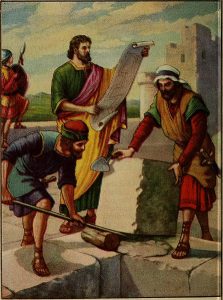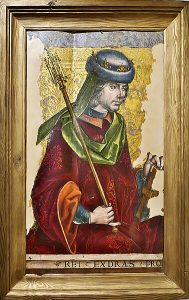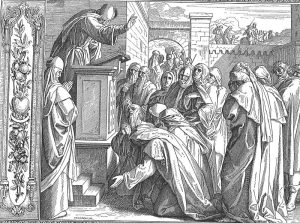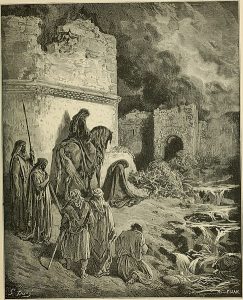The books of Ezra and Nehemiah deal with the material restoration and the reorganization of social life in Judah after the Babylonian Exile. The various events that shape this period are part of a unified project by God, even if they took place at different times, during the reigns of several successive Persian monarchs.

Nehemiah leading the rebuilding of Jerusalem´s walls
The Mission of Nehemiah
During the reign of Artaxerxes I (464-424 B.C.), complaints from the Samaritans reached the Persian court due to the rebuilding of the city of Jerusalem and its walls, prompting the king to order a halt to the works. Nehemiah, a Jew who held an important position at the court, pleaded with the monarch to authorize the continuation of the project. The king agreed and sent him there, providing letters of recommendation so that the governors would supply what was necessary to carry out the task. This occurred around the year 430 B.C. Despite opposition from the Samaritans, Nehemiah succeeded in building the walls and repopulating the city. He also reorganized social life, emphasizing aspects distinctive to the national character and promoting the organization of worship in the Temple, which had been rebuilt shortly before.

King Ezra by Pedro Berruguete
The Mission of Ezra
For his part, Ezra was a scribe from a priestly family. It is not known with certainty when he carried out his mission, though it is most likely around the year 398 B.C., during the reign of Artaxerxes II.
Ezra received a decree from the king renewing the permit that allowed for the return from exile of any Jews who wished to do so. He was also granted authority to enforce the “law of his God” as the law of the Persian state for the Jews, and he received contributions from the sovereign for the maintenance of Temple worship (Ezr 7:15).
Ezra devoted himself wholeheartedly to fulfilling this mission. Once in Jerusalem, he gathered the people near the Temple and read to them “the book of the law of Moses.” He also set in order, according to what is stated in that Law, many aspects of social life, particularly mixed marriages.
The Books of Ezra and Nehemiah
The composition of the books of Ezra and Nehemiah was based on specific sources, some of which are notably extensive.
On the one hand, the work includes significant documentation written in Aramaic. It is comprised of remnants of diplomatic correspondence with the Persian court concerning the Samaritans’ opposition to the restoration of the walls (Ezr 4:6-23) and the rebuilding of the Temple (Ezr 5:1 – 6:18). Two chancellery letters of Persian origin are also part of this collection.
Likewise, the “memoirs of Ezra” and the “memoirs of Nehemiah” are of great importance—lengthy reports written by the protagonists themselves, which are cited several times.

Ezra preaches the law by Julius Schnorr
The events narrated in these books usher in a new stage in the history of salvation, in continuity with the preceding ones. This continuity is a key element of their teaching, as they bear witness to the way in which God guides the history of salvation, advancing and progressing through the passage of time amid changing historical circumstances, eliciting new responses to the various situations that arise, yet always preserving the distinctive identity of Israel’s faith through strong bonds of fidelity to its origins.
By father Francisco Varo, priest

Nehemiah walking around the ruined walls of Jerusalem.
